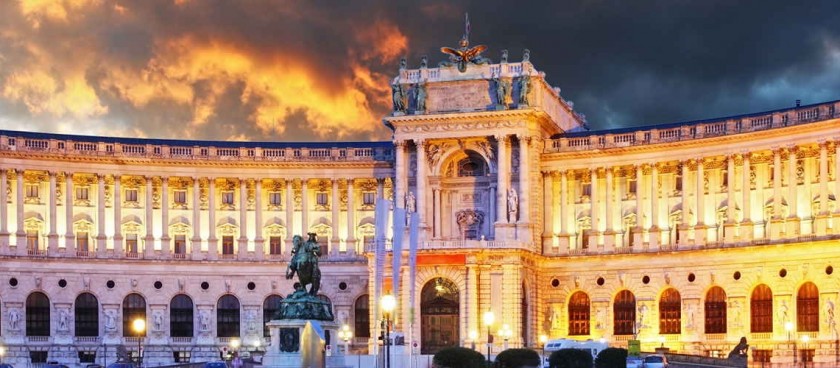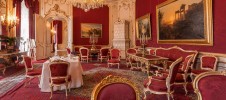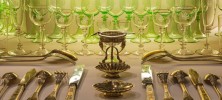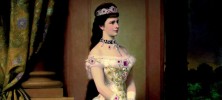- #AT02
- Michaelerkuppel, 1010 Wien, Austria
- +4315337570
- https://www.hofburg-wien.at/
- Working hours*:
September to June
9:00 - 17:30
July and August:
9:00 - 18:00 - Prices*:
Adults (with audio guide) - 15,00€
Children (with audio guide, aged 6-18) - 9,00€
Students (with audio guide, aged 19-25) - 14,00€
Disabled persons (with audio guide) - 14,00€ - * - opening and closing times as well as entrance prices, are subject to alterations without notice. Visitors are advised to check before visiting.
- Visitors are not allowed to bring in bulky objects or luggage of any kind - suitcases, bags, scooters, etc. Please note as well that there are no options available for left-luggage storage.
- 48.2076620, 16.3660550 Copy to clipboard Copy
-
#Castles , #Museums
History
The name translates as "Castle of the Court", which denotes its origins when initially constructed during the Middle Ages. Initially planned in the 13th century as the seat of the Dukes of Austria, the palace expanded over the centuries, as they became increasingly powerful. From 1438 to 1583, and again from 1612 to 1806, it was the seat of the Habsburg kings and emperors of the Holy Roman Empire, and thereafter until 1918 the seat of the Emperors of Austria. Since then the palace has continued in its role as the seat of the head of state and is today used by the Austrian Federal President.
It is also the permanent home of the Organization for Security and Co-operation in Europe (OSCE).
The whole palace complex is under the administration of the governor (Burghauptmann), who in turn is part of the Burghauptmannschaft, an office which has been in existence since the Middle Ages under the auspices of the Burgrave. At present the Burghauptmannschaft is under the jurisdiction of the Federal Ministry of the Economy.
In September 1958, parts of the Hofburg were opened to the public as a convention centre. In the first ten years, the Burghauptmannschaft operated the convention centre; since 1969 a private company (HOFBURG Vienna - Wiener Kongresszentrum Hofburg Betriebsgesellschaft) has been managing the international congress and events center. Every year the convention centre hosts about 300 to 350 events, with around 300,000 to 320,000 guests. Among the events are conventions and meetings as well as banquets, trade fairs, concerts, and balls.
Swiss Wing
The oldest parts of the palace date from the 13th century and were primarily constructed by the last of the Babenbergers, or by Ottakar II of Bohemia. Before that the castle of the Austrian rulers had been located on the square called "Am Hof", which is near the Schottenstift (Scottish Monastery).
The castle originally had a square outline, with four turrets, and was surrounded by a moat with a drawbridge at the entrance. These oldest sections of the castle today form the Swiss Court (Schweizerhof), where there are a gothic chapel (Burgkapelle), dating from the 15th century, and the treasury (or Schatzkammer), affiliated to the Kunsthistorisches Museum which holds, among other things, the imperial insignia of the Holy Roman Empire (Reichskleinodien) and of the Empire of Austria. The Court Music Chapel (Hofmusikkapelle) is located inside the Court Chapel (Hofburgkapelle) and is where the Vienna Boys' Choir traditionally sing mass on Sundays.
The appearance of the Swiss Court dates from the Renaissance, during the reign of the Emperor Ferdinand I. The Swiss Gate entrance (Schweizertor) displays the many titles of Ferdinand I and the insignia of the Order of the Golden Fleece are painted on the ceiling.
An adjoining section of the Swiss Wing houses the Radetzky Apartments. In recognition of his services in the Italian campaign during the revolutionary year of 1848, the Emperor Franz Joseph I permitted the worthy Field Marshal Radetzky to live in these apartments, even though he was not a member of the imperial family.
In the Knight's Hall (Rittersaal), on 15 May 1717 the Empress Maria Theresa was baptised by the Papal Nuntius Giorgio Spinola, representing Pope Clement XI, with baptismal water containing a few drops from the River Jordan.
Next to the Knight's Hall is the Guard Room (Trabantenstube), where the duty officer of the Household Guards kept watch over the emperor. The lower section of this wing once accommodated the imperial kitchen.
Stallburg
Although not physically connected to the rest of the complex, the imperial mews (Stallburg) of the Hofburg were originally built as a residence for the then crown prince, Maximilian. It is said that Ferdinand I did not wish to house his son under his roof, as Maximilian had veered towards Protestantism. This structure later accommodated the art collection of Archduke Leopold Wilhelm, the art-inclined brother of Emperor Ferdinand III, and the collection forms the core of the later Kunsthistorisches Museum from 1889. The residence was converted during the Baroque era to house the imperial horses on the ground floor and is used by the Spanish Riding School (Spanische Hofreitschule).
Amalienburg
Across from the Swiss Gate is the Amalienburg, named after Empress Amalie Wilhelmine, the widow of Joseph I. However, this wing had already been in use for more than a century, constructed as the residence of the Emperor Rudolph II in the style of the late Renaissance. Of note is the small tower with its cuppola and the astronomical clock on its façade.
Leopoldine Wing
The connection between the Amalienburg and the Swiss Court is the Leopoldine Wing (Leopoldinischer Flügel) which was first built in the 1660s under Emperor Leopold I and thus named after him. The architect was Filiberto Lucchese, but after the Siege of 1683 by the Turks, the wing was rebuilt by Giovanni Pietro Tencala with an additional floor installed. Through its architecture, this wing still bears a connection to the Late Renaissance. It is in this wing that the offices of the Federal President are located.
The Privy Council Room (Geheime Ratstube) is part of the wing. This is where Emperor Franz Joseph I held his opening speeches at the sessions of the Austro-Hungarian Delegation. Here the Archduke Franz Ferdinand, a nephew of emperor Franz Joseph I and heir to the throne, spoke the Oath of Renunciation on 28 June 1900 and in so doing renounced all claims to the throne for his descendants. A dynastically necessary act as his intended marriage was to be morganatic, due to the unequal rank between him and his future wife.
The lower section of this wing as well as that of the Amalienburg served as the enormous wine cellar for the Hofburg.
Imperial Chancellery Wing (Reichskanzleitrakt)
An additional father-son collaborative project resulted in the Winter Riding School (Winterreitschule) across from the Stallburg (and where the first Austrian parliament sat in 1848) and in the Imperial Chancellery Wing (Reichskanzleitrakt) across from the Leopoldine Wing. The latter was originally planned by Johann Lucas von Hildebrandt and accommodated, in addition to the Aulic Council (Reichshofrat), the offices of the Imperial Vice-Chancellor (Reichsvizekanzler), who was the de facto prime minister of the Holy Roman Empire since the ceremonial position of Imperial Arch-Chancellor (Reichserzkanzler)—whom the Imperial Vice Chancellor represented—had always been filled by the Archbishop of Mainz since the Middle Ages. After the end of the Holy Roman Empire, this wing housed the apartments of Napoleon, The Duke of Reichstadt and later those of Emperor Francis Joseph I.
The chancellery, Swiss court, Amalienburg and Leopoldine Wing form the Inner Castle Court (innerer Burghof). In the middle is a bronze statue of Francis I dressed as a Roman emperor, by Pompeo Marchesi.
Court Library
Originally a free-standing structure, the Court Library (Hofbibliothek) was housed on the other side of the complex. Charles VI had the main building and the Prunksaal main hall constructed. Today it is under the auspices of the Austrian National Library. Its construction was begun by Johann Bernhard Fischer von Erlach and finished by his son Joseph Emanuel in 1735. The large Prunksaal hall contains the book collection of Prince Eugene of Savoy, an enormous ceiling fresco by Daniel Gran, and statues of emperors by Paul Strudel making this part of the Hofburg its most significant in artistic terms. The exterior decoration with attic style figures was executed by Lorenzo Mattielli in 1726. He placed a statue of Athena riding on a quadriga above the main entrance. On the left portion of the roof, he situated Atlas, supporting the celestial globe, flanked by Astronomy and Astrology, and on the opposite side, Gaia with the terrestrial globe, flanked by allegories of Geometry and Geography.
The library to the north is located at Joseph Square.
More structures and annexes were successively added. Particularly from 1763 to 1769, Nicolo Pacassi connected the Imperial Library to the other parts of the Hofburg and its other side to the Augustinian Church and he thus created the present Joseph Square (Josephsplatz), marked by its almost symmetrical proportions.
Joseph Square
Statue of Emperor Joseph II on Joseph Square, left the Court Library, right the Redoute Wing
Of note are the bronze equestrian statue of Emperor Joseph II.
Augustinian Wing
Built right before the adjacent Court Library, on the south-east side of Joseph Square, lies the baroque Augustinian Wing with the Augustinian church and monastery. As the palace expanded, the church and monastery became an integral part of the building.
The Augustinian Church was used by the Habsburgs as their court church and also for weddings. This is where Emperor Franz Joseph I and Empress Elisabeth, alias Sisi, were married.
Behind the Loreto side chapel is located the Hearts' Crypt, a semicircular-shaped annexe separated by an iron door, where 54 hearts of House of Habsburg members are kept in silver urns.
The Palais Archduke Albrecht (formerly Palais Tarouca-de Sylva), home of the Albertina museum, is also considered a part of the Hofburg because of its structural connections to the Augustinian monastery. In the early 19th century members of the imperial family had their residence here, such as Archduke Albrecht and, later, his nephew, Archduke Friedrich, Duke of Teschen. After the renovation of the Palais in the 1820s by Joseph Kornhäusel, that section became connected to the Hofburg as well.
Redoute Wing
Wedding Supper at Redoutensaal by Martin van Meytens- the wedding of Princess Isabella of Parma and Joseph II, Holy Roman Emperor
Empress Maria Theresia had a 17th-century opera house converted into the dance and concert halls now known as the Redoutensäle, which consists of a small and a large hall. Together with a number of smaller antechambers they form the Redoute Wing.
The original plans were drawn up by Jean Nicolas Jadot de Ville-Issey [de], while the external façades are the work of Nicolò Pacassi and Franz Anton Hillebrandt [de]. The Redoutensäle soon became the setting for the cultivated style of baroque entertainment. The name is derived from the French word "wikt:redoute", meaning an elegant masked ball, and such balls were also held there. The audience was treated to music by Joseph Haydn and Nicolo Paganini and Franz Liszt. The premiere of Beethoven's 8th Symphony took place there in 1814. The well known saying "The Congress dances" derives from the balls held in the Redoutensaele in the framework of the Congress of Vienna in 1814/15. Johann Strauss served as musical director to the court for the balls held here. Over the centuries, various modification has been made the balls in line with changing tastes.
On 27 November 1992 the whole wing with the Redoutensäle was seriously damaged by fire. The reconstruction and restoration work lasted five years. While the smaller Kleiner Redoutensaal was faithfully restored, for the interior of the larger Grosser Redoutensaal a design competition was held, which was won by the Austrian artist Josef Mikl. He created a number of oil paintings based on literary quotations taken from Ferdinand Raimund, Johann Nepomuk Nestroy and Elias Canetti. His 404 m² ceiling painting incorporates 34 handwritten verses of Karl Kraus' poem "Youth", albeit in a form not visible to the viewer."[3]
The Redoutensäle reopened in 1998 in the framework of the first Austrian Presidency of the Council of the European Union and became since then part of the Hofburg Congress Center.
Restoration of the roof of the wing gave an opportunity to convert the original loft space into a new amenity called the Rooftop Foyer (Dachfoyer). The architect Manfred Wehdorn designed a modern interior, completed with a spherical structure for secure conferences and panoramic windows. Besides the roof, he also converted the former courtyard between the Hall of Festivals and the southwest wing of the Swiss courtyard to another space.
By 2017 the wing has been renovated to house the National Council and the Federal Council.
St. Michael's Wing facing the square
St. Michael's Wing was also planned by Joseph Emanuel Fischer von Erlach, and it serves as the connection between the Winter Riding School and the Imperial Chancellery Wing. However, because the old Imperial Court Theatre (Burgtheater) stood in the way, these plans remained unrealized until Ferdinand Kirschner built the wing from 1889 to 1893, utilizing a slightly altered plan.
After the completion of St. Michael's Square, two sculpted fountains were installed on the façade of the wing: Power at Sea by Rudolf Weyr and Power on Land by Edmund Hellmer.
The wing is named in reference to St. Michael's Church on the opposite side.
Montoyer Wing
The Hall of Festivities during a concert of the Vienna Hofburg Orchestra
The walls of the Marble Hall in front of the Hall of Ceremonies date back to the 16th century and theoretically belong to the Leopoldine Wing, but the scagliola for the interior was changed around 1840 to match the appearance of the newer Hall of Ceremonies. During the imperial period it was used as a dining room and for balls for the children at court.
The Hall of Ceremonies was built for Emperor Francis II/I by the Belgian architect Louis Montoyer at the beginning of the 19th century. Because of its additional nature, it formed a clearly visible protrusion at right angles to the Leopoldine Wing for almost a hundred years, and was therefore also called the "Nose".
With its ornate coffered ceiling and 26 crystal chandeliers, which once held 1,300 candles, the Hall of Ceremonies was grand. The 24 Corinthian columns are done in scagliola technique, in which painted gypsum resembles marble. In this hall Napoleon I asked for the hand of Archduchess Marie Louise, the daughter of Emperor Francis II/I. This was also where court balls were held and later also speeches from the throne. and where the exclusive Ball at the Court was held. On Maundy Thursday, the emperor and empress invited twelve poor old men and women to have their feet washed in a traditional Maundy ceremony.
Later on the Hall of Ceremonies became fully integrated into the New Castle (Neue Burg) by 1916.
With its 1,000m2 of floor space, the Hall of Festivals (Festsaal) is the biggest hall in the whole of the Hofburg. Although built as a throne room, it was never used as such. The internal works were finished in 1923, but the artwork remained incomplete. The hall has Alois Hans Schramm's three ceiling paintings, dedicated to the greater glory of the Habsburgs, complete with Emperor Franz Joseph's motto "Viribus Unitis" (with united strength). The lower lunettes and octagonal panels are decorated with paintings by Eduard Veith and Viktor Stauffer of famous people from Austrian history, with Maximilian I, Charles V, Ferdinand I, Rudolph II and Ferdinand II of Tyrol to be seen in the ceiling paintings, and Leopold I, Charles VI, Prince Eugen and also the Polish King John III Sobieski in the side panels. The hall was also the venue for 1967 Eurovision Song Contest.



